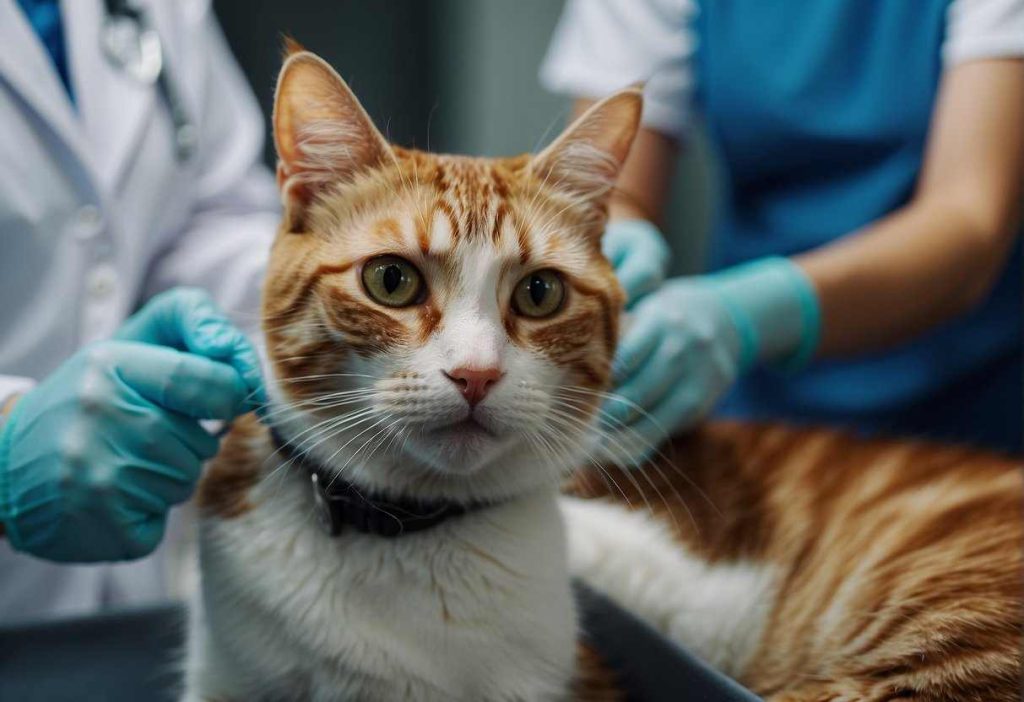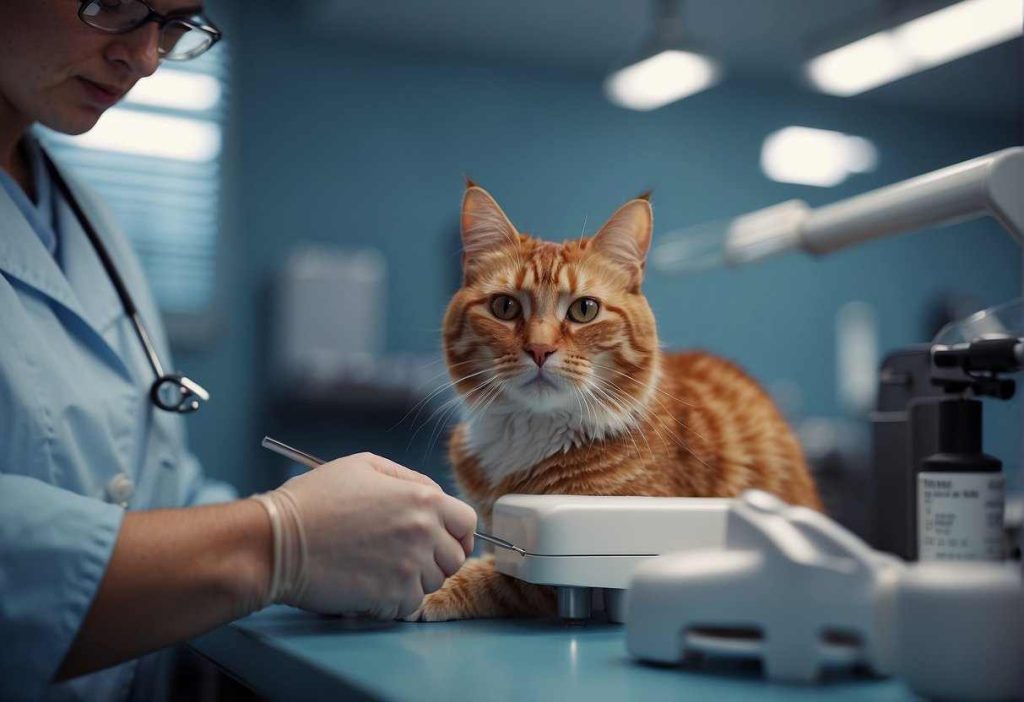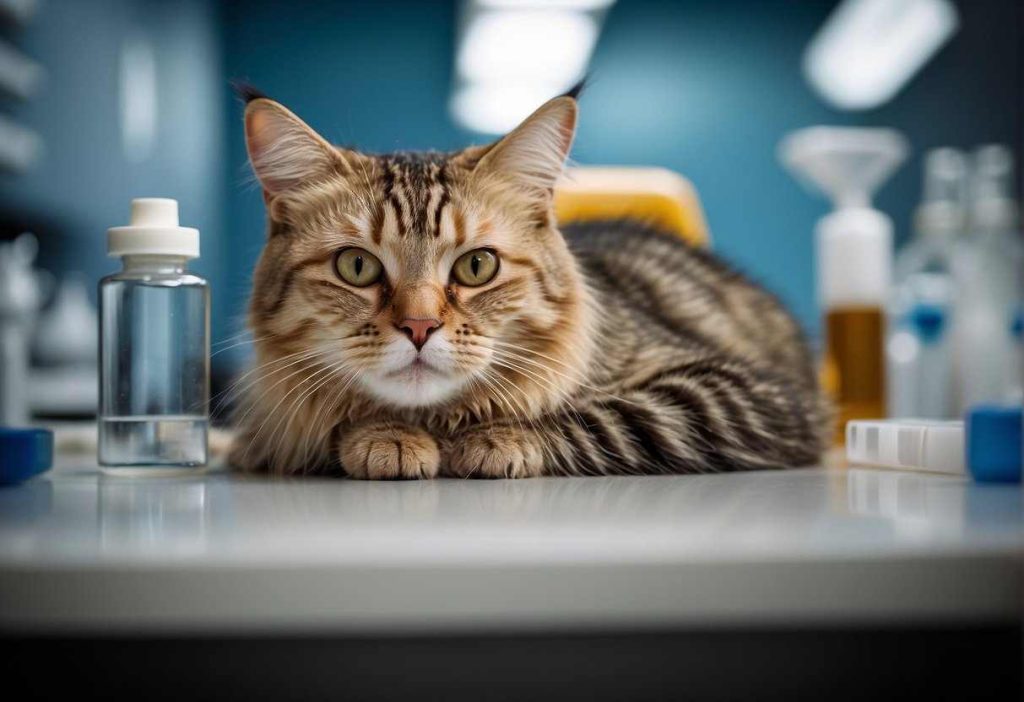Blood parasite in cats might sound like something out of a creature feature, but for our feline friends, they’re a serious reality that can lead to significant health issues.
Wondering what exactly blood parasites are?
Imagine tiny, uninvited guests taking up residence in your cat’s bloodstream, causing a range of problems from mild illness to severe, life-threatening conditions.
As a cat owner, it’s important to understand these parasitic infections, such as the cat’s blood, which can secretly wreak havoc on your cat’s health.

You’ve probably heard of some of these creepy crawlies by name—like babesiosis, cytauxzoonosis, or hemotropic mycoplasmosis, also known as feline infectious anemia. (1)
While some blood parasites are relatively uncommon, others might be lurking in areas you’d least expect, putting your cuddly companion at risk.
They can be transmitted in various ways, from tick bites to blood transfusions, or even between a mother cat and her kittens.
Symptoms can vary widely, but they often include lethargy, anemia, fever, and in severe cases, can even lead to death.
The good news? Knowledge is power, and by being informed, you can help protect your kitty from these dangerous parasites, especially if they are wild cats.
So how common are these parasites among our purring pals?
While statistics on prevalence can vary based on location and lifestyle (indoor versus outdoor cats), parasitic blood infections are definitely on the list of concerns for vets and cat owners alike.
Recognizing the signs early on can lead to timely diagnosis and treatment, including the use of intravenous fluids, greatly improving outcomes for infected felines.
Key Takeaways
- Blood parasites can cause severe health problems in cats, ranging from mild sickness to fatality.
- Early recognition of symptoms and accurate diagnosis are critical in managing parasitic blood infections.
- Knowledge about transmission, prevention, and treatment is essential for feline health.
Blood Parasite in Cats: Symptoms and Causes

Knowing what symptoms to look for and understanding how our cats get infected are crucial first steps to keeping them healthy.
Identifying Common Symptoms:
- Anemia: Is your cat’s gum paler than usual? Anemia is often a telling sign.
- Lethargy: When your once energetic cat now prefers to sleep all day, it’s worth a second look.
- Loss of Appetite: Are they leaving the food bowl untouched? Decreased interest in food can indicate an issue.
These symptoms can disrupt your cat’s happy life, so early recognition is key. Now, you might be wondering – how does my cat even get these parasites?
Understanding Causes and Transmission:
Cats are curious creatures, but their explorations can expose them to nasty critters like ticks and fleas, which are common vectors.
These tiny pests can transmit parasites when they bite your beloved cat, leading to infections such as haemobartonellosis, caused by bacteria that lack true cell walls, making them tricky to tackle, since they’re resistant to some antibiotics.
Cats can also become infected with this parasite through the bite of a tick, specifically the Lone Star tick or American dog tick, and not directly from another infected cat or tick ingestion.
Remember, if you spot any of these symptoms, a quick trip to the vet could make a world of difference. It’s all about keeping our purring friends in tip-top shape!
Diagnosis and Early Detection

Catching these uninvited guests early can make a world of difference to your cat’s health.
Early Detection: The sooner you spot these blood invaders, the better.
Symptoms can be sneaky, and your feline pal isn’t going to fill you in. Keep an eye out for tell-tale signs like fever, lethargy, or jaundice. (2)
Did you know that early diagnosis is key to successful treatment?
It’s true!
The right diagnosis can turn a potentially life-threatening situation into a manageable one, especially in the early stages of the disease.
Diagnostic Methods: Here are the trusty tools vets use to unveil the microscopic culprits:
- Blood Smear: A drop of blood on a slide, a quick stain, and voila! Parasites are visible under a microscope. (3)
- PCR Assays: Think of this as the CSI of veterinary diagnostics. The Polymerase Chain Reaction is a high-tech method that can identify the DNA of the parasites. Super cool and super accurate! (4)
Here’s a snapshot of these methods:
| Method | Description |
| Blood Smear | Direct observation of parasites on stained slide |
| PCR Assays | Detection of parasite DNA for accurate diagnosis |
Remember, your cat’s well-being could depend on a simple blood test. No exaggerating!
If anything seems off, a quick trip to your vet can put your mind—and your cat’s health—in a better place.
So let’s keep those sneaky little blood dwellers in check and your purring pal thriving!
Treatment Strategies for Blood Parasites

When your fluffy friend has a blood parasite, you might feel overwhelmed. But don’t worry! We’ll go through some treatment plans together.
Conventional Treatment Approaches
Typically, antibiotics are the frontline warriors against these microscopic menaces. For instance:
- Hemotrophic Mycoplasmosis (formerly known as Haemobartonellosis) often requires antibiotics such as doxycycline. (5)
- Babesiosis might be treated with a combination of clindamycin and quinine. (6)
Remember, while these medications are potent, they’re not magical. It might take a week or so before you notice your cat feeling spunkier.
Supportive Care and Management
Your vet might suggest some supportive treatments to help your cat kick the infection:
- Fluid Therapy: Keeps hydration up and organ function optimal.
- Blood Transfusions: Necessary in severe cases where your cat’s red blood cell count is alarmingly low.
You’ll also need to schedule follow-ups with your vet to keep track of your cat’s progress through blood tests.
Alright, armed with this plan of attack and a dollop of patience, you’re ready to stand by your cat’s side in their skirmish against blood parasites. Just imagine those little invaders waving a white flag!
Preventing Blood Parasite Infections
It’s all about being proactive, and here’s how you can do just that.
Keep Fleas and Ticks in Check
First things first, fleas and ticks are not just a nuisance, they’re a ticket for blood parasites to hop onto your cat. So, what can you do?
- Use flea and tick control products: Regularly apply vet-recommended preventatives.
- Inspect your pet after outdoor visits: Check for freeloaders who have hitched a ride.
Embrace a Clean Environment
Your cat’s environment plays a role as well:
- Maintain a clean living area: Regular vacuuming and washing of your cat’s bedding discourages pests.
- Groom your cat regularly: A good brush can help spot any unwelcome guests early on.
Watch Out for Mosquitoes
Mosquitoes can be more than a buzzkill; they can transmit heartworm. Keeping your cat indoors during peak mosquito hours and using mosquito repellents designed for cats can help reduce the risk.
Consider Preventative Medications
Talk to your vet about:
- Heartworm preventatives: They’re a must, especially in high-risk areas. (7)
- Anti-parasitic medications: Ask if they’re right for your cat’s lifestyle.
After Infection: A Long-Term View
If your cat does get a blood parasite, here’s some long-term love:
- Follow your vet’s treatment plan closely.
- Regular check-ups post-infection are crucial.
- Keep up with preventive measures, because once is enough!
Being vigilant and keeping up with these tips can help ensure your feline friend stays healthy and parasite-free. Remember, a little prevention goes a long way!
Comprehensive Understanding of Blood Parasite in Cats

Blood parasites—yes, those unwelcome guests hitching a free ride in your cat’s circulatory system. Let’s break it down.
Types of Blood Parasites in Cats:
- Protozoa: Think of single-celled organisms, like Babesia and Toxoplasma.
- Bacteria: These can be a bit more complex. Ever heard of Mycoplasma? That’s one of them.
- Rickettsiae: Kinda like bacteria but also not really. They’re in their own unique category.
| Parasite | Impacts on Cats | Transmission Method |
| Protozoa | Potentially severe illnesses | Insects, contaminated water |
| Mycoplasma | Infects red blood cells | Mostly ticks and fleas |
| Rickettsiae | Could lead to various diseases | Tick bites |
You might be itching to know how these microscopic invaders affect your feline friend. They can range from meh (mild illness) to “Oh no!” (severe anemia or worse).
Now, let’s talk nerdy—scientifically, of course. For instance, hemotropic mycoplasmosis, previously known as feline infectious anemia, is a classic case where bacteria sidle up to your cat’s red blood cells.
And they’re quite the stubborn guests, resisting antibiotics and slipping under the radar.
Remember, diagnosing these silent invaders often takes more than just a glance under the microscope—think molecular techniques, especially when infections get all sneaky and chronic.
Are you curious if your cat might be hosting these parasites? Some telltale signs include fever, weakness, and pale gums. But the real diagnosis happens at the vet’s office, so don’t play Dr. Cat Whisperer at home.
So, keep an eye out, and let’s keep those bloodsuckers at bay for a happy, healthy kitty!
Practical Advice for Pet Owners

Everyday Care:
- Monitor Your Cat: Keep an eye on your cat’s behavior. If they seem lethargic or have lost their appetite, it’s vet time.
- Tick Checks: Ticks are a common culprit. Give your cat a once-over, especially after outdoor adventures.
Parasite Prevention:
- Tick Control:
- Use vet-recommended tick prevention products.
- Remember to apply or administer them as instructed.
- Vaccinations and Vet Visits:
- Stay up-to-date on vaccinations.
- Routine check-ups can catch issues early.
If Your Cat is Diagnosed:
- Stay calm. Follow your vet’s treatment plan.
- The red blood cell count can clue you in on recovery progress.
Reducing Risks:
- Limit Exposure: Keep your cat indoors or supervise outdoor time.
- Tick Habitats: Avoid areas known for ticks.
Remember, your cat can still carry parasites even after recovery, so maintaining these practices is crucial.
Here’s a quick tick-check guide:
| Step | Action |
| 1 | Check skin and fur. |
| 2 | Look in hidden spots like under collars. |
| 3 | Use fine-toothed combs. |
| 4 | Remove ticks immediately and safely. |
By breaking these steps into your everyday routine, you’re not just a pet owner—you’re a superhero in the battle against blood parasites. Keep it up, champ!
Broadening the Scope of Information

Let’s dive into the world of cat blood parasites—far beyond the well-known Feline Hemotrophic Mycoplasmosis (which is already quite a mouthful, don’t you think?).
Different Culprits to Watch Out For:
- Cytauxzoonosis: Ever heard of it? This one’s a real tough cookie, transmitted by ticks and often found in the southern and southeastern US. It doesn’t play nice, often leading to serious illness in domestic cats.
- Haemobartonellosis: Try saying that three times fast! These bacteria adore red blood cells and can make our kitty pals quite sick.
Why Should You Care?
Because knowledge is power! Knowing what’s out there can help you keep your cat safe. Plus, let’s face it, it’s pretty interesting, right?
- Real-life Cases: Imagine it’s a sunny day in the Southeast. You spot a tick on your tabby—uh oh! Next thing you know, they’re feeling under the weather. It could be Cytauxzoonosis.
- Your indoor-outdoor adventurer returns looking a bit peaked. The culprit? Possibly Haemobartonellosis.
By understanding these diseases, you can be on the lookout and act quickly if you suspect something ticky or downright peculiar is going on with your cat’s health.
Remember, these little parasites can be stealthy, but with your newfound knowledge and by scheduling regular physical exams for your cat, you’ll be one step ahead.
Keep those eyes peeled and give your furry friend the protection they deserve!
Quick Recap

Did you catch all that about blood parasites in our feline friends? Here’s the skinny:
Blood Parasites in Cats: These tiny invaders range from single-celled protozoa to bacteria and can be quite the headache for your cat.
- Common Types: You’ve heard about Haemobartonellosis—ring a bell? That’s when red blood cells wave a white flag under a mycoplasma attack. There’s also the notorious Cytauxzoonosis, where a protozoan parasite throws a party in your cat’s body.
- Transmission: Ever wonder how they hitch a ride? Often, ticks or flies are the guilty culprits, looking for a free lift via their bites.
- Symptoms: Keep your eyes peeled for mood blues, anorexia, and fever—your cat’s SOS signals for these unwelcome guests.
- Diagnosis and Treatment: Vets play detective with blood tests to pinpoint the pesky parasites. Then, they’ll swoop in with the right treatment, but here’s a heads-up: post-recovery, your cat might still be a cozy carrier.
For more intel, just follow these breadcrumbs:
- MSD Veterinary Manual: Your go-to for an in-depth look at blood parasites in cats.
- PetMD: Get the scoop on what to expect post-treatment for Haemobartonellosis.
- VCA Animal Hospitals: Offers a wealth of knowledge on Feline Hemotrophic Mycoplasmosis.
Remember, keeping your furry buddy up-to-date on preventatives is key. A quick vet check-up can save you heaps of worries. So stay alert, stay informed, and give those parasites the boot!
Frequently Asked Questions
When dealing with the health of your furry friend, being informed is crucial. Blood parasites in cats can be a serious concern, but knowing the signs and prevention can help you protect your pet.
Let’s dive into some common questions cat owners have.
What are the first signs of blood parasites in cats?
You might first notice lethargy, loss of appetite, or pale gums in your cat, which can signal anemia caused by parasitic infections like feline hemotropic mycoplasmosis.
If your cat has a tick-borne disease, such as cytauxzoonosis, symptoms may include high fever and difficulty breathing.
How can I prevent my cat from getting blood parasites?
To play it safe, regularly use tick and flea prevention products and keep your cat away from environments where these pests thrive.
Keeping your indoor-outdoor cat’s environment clean and monitoring their interaction with other animals can also reduce the risk.
Are certain breeds more susceptible to blood parasites?
There’s no specific breed that’s at greater risk; however, cats with outdoor access or those living in areas with high tick populations are more exposed to blood parasites.
Always keep an eye on your adventurous companion, regardless of their breed.
What should I do if I suspect my cat has a blood parasite?
Time to play detective with your vet! Schedule a visit to confirm the diagnosis. They might perform blood tests to assess red blood cell count and check for parasites.
Early detection and treatment are pivotal in managing the infection.
Can blood parasites in cats be completely cured?
Some parasites, like hemotropic mycoplasmas, can be treated effectively with antibiotics.
However, post-treatment, your cat might still carry and transmit the parasite. Other diseases may be more challenging to cure, so it’s important to discuss options with your vet.
Is it possible for indoor cats to get blood parasites?
Yes, although it’s less common since indoor cats have limited exposure to ticks and fleas.
Still, those pesky pests can hitch a ride inside on clothes or other pets, so it’s wise not to skip on year-round preventive measures even for the homebodies.
What are the long-term effects of blood parasites on a cat’s health?
Chronic infections can lead to serious health conditions like organ damage or severe anemia. Even after recovery, your cat might have a weaker immune system.
Continuous monitoring and care can help manage and mitigate long-term health implications.
Stay informed and keep an open line with your veterinarian for the healthiest and happiest kitty life.


